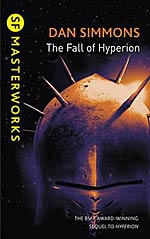
![]() Mattastrophic
Mattastrophic
1/19/2012
![]()
The Fall of Hyperion is the sequel to the lauded Hyperion by Dan Simmons. The first book introduces the world of Hyperion, a backwater protectorate of the galaxy-spanning human Hegemony. Hyperion is an oddity, partly due to the enigmatic time tombs in the northern lands (temples and catacombs with no obvious purpose, each on distinct, and moving backwards in time, thumbing entropy in the eye), but largely due to the Shrike: a four-armed monster with glowing red eyes covered head to tow in razor-sharp spikes. The Shrike is so mysterious that a religion has grown up around it, and Hyperion began with seven people sent by the Shrike Church for the final pilgrimage to the Shrike before the world of Hyperion falls to an alien force. The Shrike is rumored to grant a wish to a pilgrim if he doesn't impale him or her on his tree of thorns first. Hyperion took the form of a series of collected tales told by the pilgrims on their journey in a deliberate homage to The Canterbury Tales. Each pilgrim had a run in with the Shrike in some way: some want to kill it, others know it will kill them. Hyperion ended on a massive cliffhanger as the Pilgrims were approaching the Time Tombs. The Fall of Hyperion casts away the collected-tales format for a more traditional narrative format, but wheras each story in the previous book felt like it was given an appropriate length, this book feels like a real slog due to its length. The story tries to tell the tale not only of the pilgrims but of the leaders of the Hegemony of man struggling not only against the weirdly-evolved humans invading but also the AIs that control too much of everyday life in the Hegemony. The Shrike and the pilgrims are the centerpiece of it all and much depends on their choices. The book does answer the questions from the first book, it continues Simmons pleasantly-evocative narrative style, and it does have some mind blowing scenes. All of this, however, feels a bit too far out there at times: the mythology Simmons is playing with and the epic plot events seemed a bit too convoluted at times, if not simply heavy handed. Keeping track of all the big reveals and their implications is a bit like trying to keep track of the Matrix trilogy. And did I mention that it's a long book? Also, only one character really develops much in this book, the President of the Hegemony. The character arcs of the pilgrims start in their climax and move to their denoument, and feel static at times. It also relies heavily on intimate knowledge of the tales from the first book, so don't wait a year to read the sequel like I did. Still, it was worth reading: it was exciting in a lot of places, mysterious, suspensful, and mindblowing in several places. Open it to any random point and you are guaranteed to find some well-crafted prose and cool worldbuilding, but it feels like it's either stalling or in a holding pattern at times. Final verdict (well, my final verdict): not quite up to the calibur of the first book, but certainly worth reading and considering.
http://www.strangetelemetry.wordpress.com